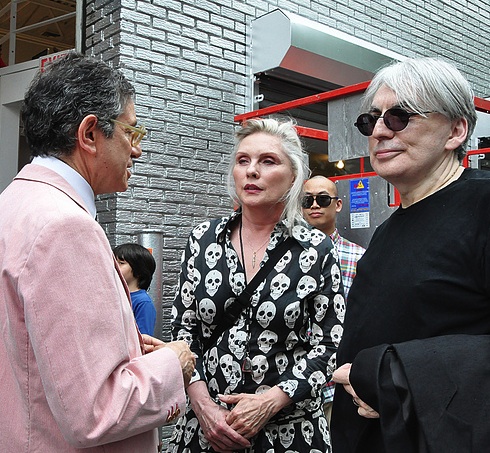In the Future, We Will All Be Posters

PHOTOS BY JENNIFER MACCHIARELLI
For those living under a rock or not searching for “Hitler” on YouTube, Jeffrey Deitch is heading to Hollywood to head up the ailing MOCA. His last exhibition while allowed to operate commercially is the work of Shepard Fairey. It’s a controversial choice not only because of the ongoing questions of fair use (and truthful behavior) in Fairey’s famous posters featuring President Obama, but because because Fairey makes a very refined and designed type of street art that does not match the tastes of the art world at large. The questions at stake are emblematic of how Jeffrey Deitch has held New York’s attention for so long.
Because, of course, the regular world is much larger than the art world, and the world at large seems to appreciate Fairey, the opening of May Day, the celebration of worker’s rights and the Deitch Projects swan song, drew a sizable crowd. Sweaty, exuberant onlookers poured onto Wooster Street, and wrapped around the block to Grand Street, exercising their rights to take pictures. Towering in front of the gallery was a massive mural, one of many throughout the city but featuring five youthful guerillas posing with guns stuffed by flowers. Onlookers whipped out cameras to document the appearance of graffiti’s most famous face, the celebrities in attendance, and the end of an era.
Speaking to the exhibit’s director, Deitch’s Andrea Cashman, the lively close was an apt send-off. “Street art has always been an important part of the Deitch Projects program. It makes sense for our last project to celebrate this history with an artist who has such an incredible presence in art today.” Cashman, who has worked at the gallery for nearly five years. “I didn’t even have a moment to be introspective. Only once, when we closed the gallery gates at the end of the night did it hit me.”
Fairey’s work called attention to the worker, the laborer and the everyman, and thus everyone who waited in line got a limited edition posters. “Given how many people came to the show, it was important for Shepard to make sure everyone had a chance to take something home,” Cashman explains. The walls were adorned by legends, like Patti Smith, Basquiat and Joe Strummer, people who Fairey chose because, as he says in his artist statement, “They started on the margins of culture and ended in the mainstream.” And they end up on a poster.






